There is still hope that the situation will improve by the summer months, but certainly no promises at this point in time.
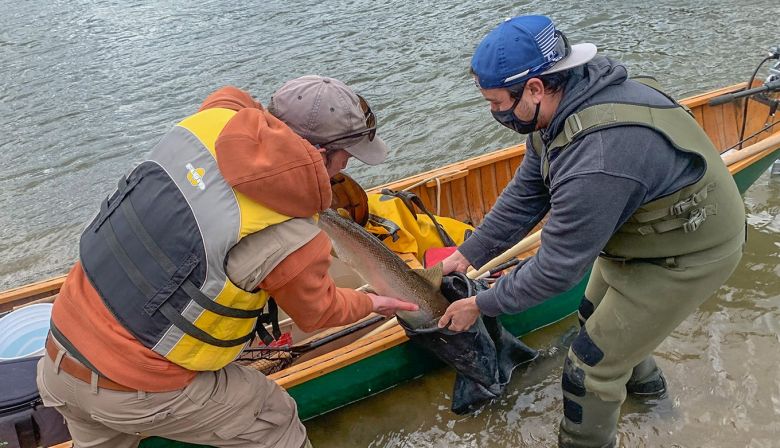
Subscribe & stay up-to-date with ASF


Tracking wild Atlantic salmon kelts and smolts downstream in their natal rivers and out across the vast ocean is absolutely vital to unravelling the mystery of high mortality at sea.
This is the 19th year that smolts have been tracked making their way unguided out to sea. It is the 15th year for tracking adult kelts on their return to the ocean having already spawned. ASF provided the vision, but even from the beginning there were partners, especially DFO and VEMCO, the latter developing increasingly sophisticated and miniaturized tracking technology.
In that time, ASF has implanted transmitters in 4,500 smolts in various rivers in the Maritimes and Quebec, and 550 transmitters in kelts.
Now this vision has come to encompass a wide array of organizations, together with ASF building a collaboration with a wide array of skills, sources of funds and especially determined individuals to see the vital need for the research.
On the Restigouche River these past couple of weeks, ASF, NB DNR staff and volunteers have been assisting Gespe’gewaq Mi’gmaq Resource Council (GMRC) with catching and tagging kelts. It has being extremely successful.
This is just one part of the Environmental Sciences Research Fund (ESRF) program, which is an Indigenous collaboration with DFO and NGOs throughout Atlantic Canada. The program aims to tag and track Atlantic salmon kelts and smolts on a broad scale throughout eastern Canada and into the North Atlantic Ocean to help answer larger scientific questions about their migrations, most especially the places and circumstances where high mortality rates are thinning the numbers of this charismatic species.
Below is one surgery, where ASF’s Biologist Graham Chafe is inserting a transmitter this year. The kelt is first anesthetized, then the surgery takes less than two minutes before the fish is returned to a small pen to recuperate, before being returned to the river to continue its migration.
The kelts in 2021 appear to be in especially good condition, and in good numbers, which in itself is cause for celebration, as it will improve their chances of successfully making yet another round trip to Greenland waters.
https://vimeo.com/542282499
The acoustic transmitters provide identification and other data as the fish swim through lines of receivers in places like the Baie des Chaleurs, at the Strait of Belle Isle, and through a line stretching seaward from near Port Hope Simpson, Labrador.
A second type of transmitter is also being used – satellite “pop-off” transmitters. These are attached externally to the salmon, and after a set number of months, or if a salmon dies or is eaten by a predator, the buoyant transmitter rises to the ocean surface and sends data to satellites in space. Temperature, depth, and travel details can all be retrieved. If the Atlantic salmon has died, information on temperature can help determine whether it was eaten, and if so, information on which predator species is most likely.
ASF has not just worked with the satellite tags in eastern Canada. We have also worked with NOAA, DFO and KNAPK to capture adult Atlantic salmon in Greenland waters, especially near Qaqortoq in the southwest of the country. Once again, collaboration among origins is key to pushing forward this important work of understanding Atlantic salmon movements.
Recently ASF Biologist Graham Chafe gave a 13-minute ZOOM presentation on ASF’s kelt tagging program.
https://vimeo.com/540777724
The raw data is just the first part of this important research.
Now with many years of information, inherent patterns can be explored for details, and changes can be observed. For example, on the Miramichi, ASF’s tracking data began several years before the explosion of the striped bass that have become a major predatory species, especially in the Miramichi. The information derived from the tracking program has proven invaluable in understanding the relationship between the two populations.
Another important direction for researching has been understanding the details of the smolt migration from rivers such as the Miramichi, Restigouche and Cascapedia across the Gulf of St. Lawrence, and what physical factors are impacting this movement of millions of young Atlantic salmon.
ASF Biologist Jason Daniels recently provided insight on how temperature impacts the migration, and affects the movement as the smolts move toward the Strait of Belle Isle, the narrowing of the ocean between Labrador and northernmost Newfoundland.
This understanding of the nature and dates of the migration could be absolutely vital in safeguarding that movement.
Jason Daniels’ 35-minute ZOOM overview of this research is yet one more example of how the Atlantic salmon tracking program is helping us better understand the risks and mortality of the species, and to improve the numbers returning to Canadian and American rivers where possible.
https://vimeo.com/540806402
Non-governmental organizations and First Nations are playing an increasingly important role in such field work.

The Maine DMR smolt trapping is showing increasing numbers beginning their long, perilous journey out to sea.
At the Sandy River, a tributary of the Kennebec, 204 smolts were counted in the smoltwheel, to Apr. 27. These are all of wild origin.
On the East Machias, 23 were counted at the Jacksonville Bridge trap, with five being recaptures. All originated at the East Machias hatchery of the Downeast Salmon Federation.
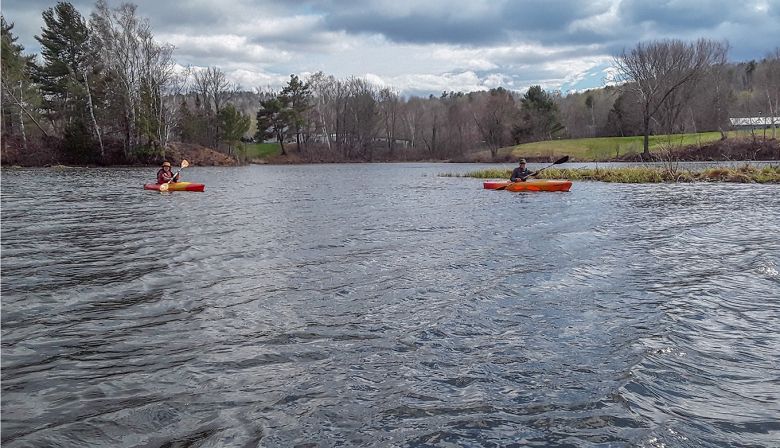
ASF’s Maranda Nemeth, Director of the Maine Headwaters Project, has been in the field working towards removal of the Walton’s Mill Dam.
At the Walton’s Mill Dam Removal Project, ASF is striving to foster a collaborative partnership to create opportunities for undergraduate students to gain hands-on learning experiences but also to combine resources to closely characterize the physical, chemical, and biological response of Temple Stream to the dam removal.
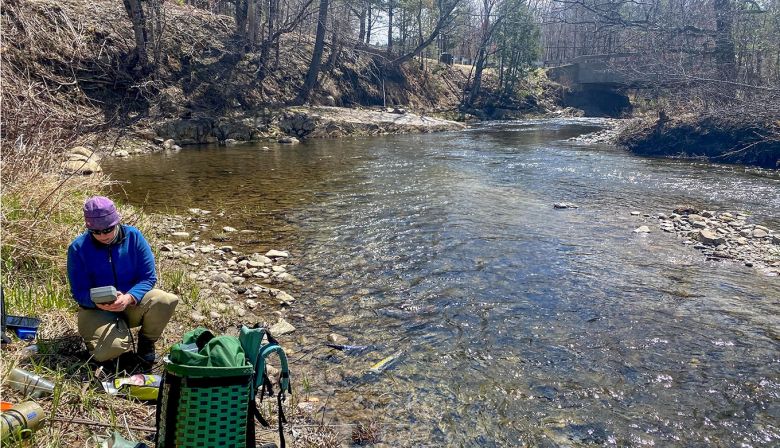
BONAVENTURE
Les Assemblées annuelles générales à l’ère du ZOOM…
Mardi dernier, l’APSB (Association des pêcheurs sportifs de la rivière Bonaventure) a tenu son assemblée générale annuelle.
L’AGA 2021 a suscité beaucoup d’intérêt qui a résulté à la participation de plus de 500 personnes à l’appel Zoom, un taux de participation record pour l’association qui a duré 4 heures. Techniquement, la soirée a eu très peu de défis à l’exception du fait que les microphones habituels n’étaient pas allumés et que les courriels de confirmation de vote prenaient un peu de temps à être livrés (surtout pour ceux qui utilisent l’iPad).
Outre les procédures habituelles d’approbation des procès-verbaux, les rapports financiers pour 2019 et 2020 en raison de la pandémie et d’autres éléments coutumiers ont été traités. La plupart des gens exerçaient leurs droits en tant que membres afin de poser des questions sur le projet (évolutif) de cohabitation qui avait été soumis au gouvernement plus tôt en avril (sans consulter l’ensemble des membres).
Des réalités telles que le nombre de fosses désignées interdites à la baignade (22 sur 98 fosses identifiées) et les interprétations des statuts de l’association ont suscité beaucoup de consternation. Les échanges étaient très civils, mais une tension sous-jacente pouvait être ressentie lorsque quelqu’un était reconnu par le président de la réunion. La plupart des participants sont vraiment inquiets pour l’avenir des saumons de la Bonaventure en raison des utilisations mixtes toujours croissantes dans le bassin versant.
L’élection de 4 postes au sein du conseil d’administration était également à l’ordre du jour. Les 7 candidats ont tous eu l’occasion de présenter pourquoi nous devrions envisager de les élire (4 hommes et 3 femmes). Avec les gens qui siègent déjà au CA de l’APSB, les personnes suivantes ont été élues pour un mandat de 2 ans qui devront s’attaquer à des enjeux très importants qui détermineront l’avenir de la ressource sur la Bonaventure, nous leur souhaitons bonne chance:
Christian Babin, Laurence Galarneau-Girard, Andrew Gilker et J.P. Tessier.
Un vote important a également eu lieu concernant l’inscription obligatoire via la Zec de tous les canoéistes qui descendent quotidiennement sur la rivière pendant la saison. Cette motion a été adoptée avec 86% des électeurs votant en faveur de cette mesure qui sera amendée au projet de cohabitation et sera soumise au MFFP pour examen.
À ce stade, tout est dans l’air, il faut attendre que le MFFP (ministère des Forêts, de la Faune et des Parcs) donne son aval (la saison de pêche débute en 32 jours) ou impose ses propres mesures temporaires pour la saison 2021 afin de trouver une solution permanente à temps pour la saison 2022.
La cohabitation, oui, mais rappelons à tous les utilisateurs que la première considération doit être accordée à la sauvegarde de la raison même pour laquelle la Bonaventure détient un statut si particulier: la population de saumon atlantique.
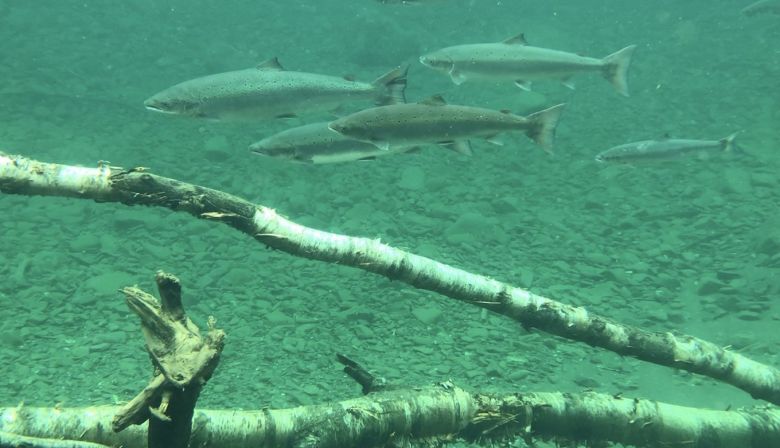
On Tuesday, April 27, the Bonaventure River Anglers Association (APSB) held its annual general meeting.
The 2021 AGM generated a lot of interest. Over 500 people participated on the four-hour meeting on Zoom. It was a record turnout, and other than a few minor technical glitches, the event ran smoothly.
First there were the administrative details: approval of the minutes from the previous meeting, accepting the financial reports for two years, 2019 and 2020, due to the pandemic situation and a few other housekeeping items. Next on the agenda was the item which had generated such elevated interest in this AGM– the draft Cohabitation Agreement that was submitted to the government earlier in the month, without prior consultation with the general membership.
Concerns were raised about the number of pools being designated as off-limits to swimmers (22 out of 98 identified pools). There were also questions about the interpretation of the association’s statutes stipulating when membership cards can be sold. Exchanges were very civil, but even in this virtual setting I could sense the tension with each question. There was no doubt the overwhelming majority of the participants are genuinely concerned about the future of the salmon in the Bonaventure River as it comes under increasing pressure from a widening number of users and activities.
Other important items included the filling of four board of directors’ seats. Seven candidates put forth their platforms and Christian Babin, Laurence Galarneau-Girard, Andrew Gilker and J.P. Tessier were elected to two-year terms. They will be faced with very important issues that will determine the future of the resource on the Bonaventure, and we wish them well.
One last item was a resolution regarding the mandatory registration of all canoeists that float the river. The motion that these users must register daily at the ZEC was approved by an 86% majority. This measure will now be amended to the draft Cohabitation agreement and submitted to the Forests, Wildlife and Parks Ministry (MFFP) for their consideration.
The MFFP must now approve, deny, or impose their own temporary measures for the 2021 season and come up with a permanent solution going forward. Until such time, access to the Bonaventure River will remain a chaotic affair with anglers, swimmers, canoeists, and other users all wanting to enjoy this unique part of Quebec’s wilderness heritage.
Yes to a cohabitation framework agreement, but let us remind all users that first consideration must be given to safeguarding the very reason the Bonaventure has such special status—it’s population of Atlantic salmon.
https://vimeo.com/543388826
After the release of a log jam last winter sent a large pulse of water over the NB Power generating station on the Nepisiguit River, the utility is upping safety measures by installing an alarm warning system for anglers, canoeists, and hikers downstream.
If you hear the siren, head for high ground because there could be a surge of water headed your way. Such sirens are common on other dams, but the Nepisiguit dam was unequipped until now.
According to NB Power’s website, the Nepisiguit dam was built in 1921 and acquired by the utility in 2007 from a previous owner.
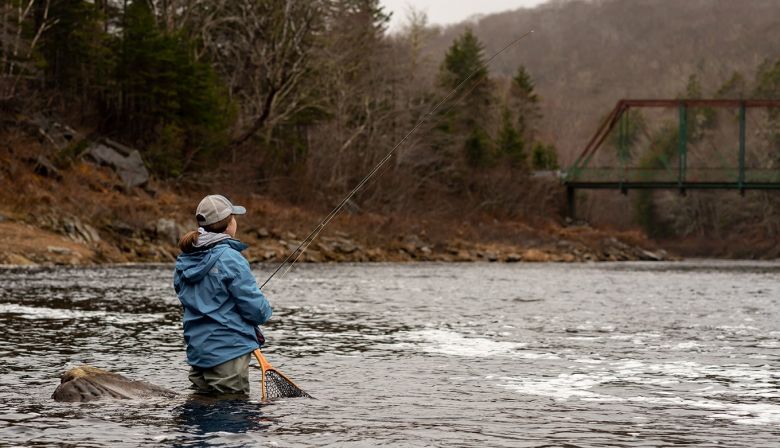
There is still hope that the situation will improve by the summer months, but certainly no promises at this point in time.